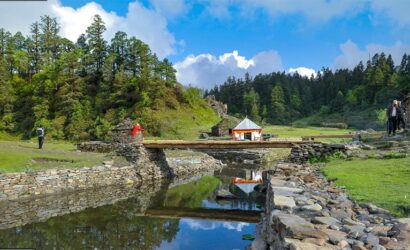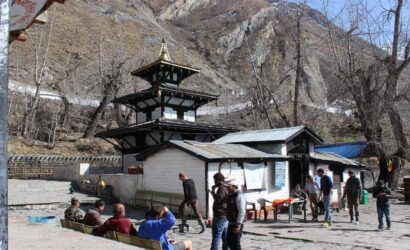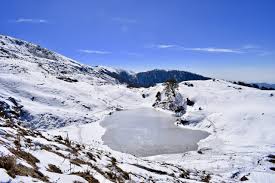Overview
The Rupin Pass trek is a popular multi-day trek in the Himalayas, connecting Uttarakhand and Himachal Pradesh, India. It’s considered a moderately difficult trek, offering diverse landscapes like valleys, waterfalls, cliffs, and snow-covered areas. The trek typically starts in the Dhaula region of Uttarakhand and ends in Sangla, Himachal Pradesh.
Itinerary
Your Trek begins in Bawta, a peaceful Himalayan village located in the mountains. The journey to Bawta is a long but pleasing drive from Shimla, with views of the valleys and rivers along the way. If you have opted for transportation with us, our team will pick you up from the Shimla Bus Stand, and together, we’ll head towards this charming base camp.
Leaving Shimla behind, the road takes you through mountain terrain. You’ll pass through Rohru, a small town on the bank of the Pabbar River, which also serves as the last ATM point before the trek. After Rohru, the route splits. One leading to Janglik, the base camp for Buran Ghati Pass Trek, and the other leading to Bawta, your base for Rupin Pass Trek.
Bawta village stands out for its traditional Kath-kuni style wooden houses, crafted from deodar cedar wood. These homes are not only aesthetically beautiful but also exude a rich, woody fragrance, and provide an extremely warm and comforting atmosphere. The thick wooden walls make the interiors cozy and well-insulated, that is perfect for the chilly mountain nights.
At night, you can step outside and look up. The sky over Bawta is dotted with countless twinkling stars. The quiet, starlit surroundings make for a peaceful and magical evening before you settle in for a good night’s rest.
The trek from Bawta to Jakha starts with a mix of trails, including sections of unpaved roads leading to Jiskun village. As you walk through this quaint Himalayan settlement, you'll notice traditional wooden houses reflecting the architectural charm of the region.
Shortly after Jiskun, one of the most scenic parts of the trek unfolds, where small water streams flow gently along the path. You will cross a wooden bridge built over these streams, a simple yet beautiful structure that perfectly complements the natural charm of the trek.
As you progress further, the trail takes a steep ascent toward Jakha, the highest and last village on this route. Due to its location on a steep slope, Jakha, often called the “Hanging Village,” is a fascinating sight. Settled on a steep slope, it seems to blend seamlessly with the mountains. The houses here are built in a way that they appear to be stacked on top of one another. This unique layout creates a unique sight.
After reaching Jakha, you will settle into a traditional homestay. The cozy interiors provide warmth and comfort after a day’s trek. The evening presents an opportunity for further exploration. You can take an acclimatization walk to Dhara Village, where the temple of Dhara Devta stands. Locals hold deep faith in this deity, and the visit provides a glimpse into the spiritual side of life in these remote mountains.
With a fulfilling day behind you, you can rest in the comfort of your homestay, preparing for the adventure that lies ahead.
You start from Jakha, passing through wooden houses, a playground, and farmlands. The first few hundred meters are steep, but soon the trail levels into a gradual ascent. Along the way, you'll come across an old wooden house, weathered by time and nature, standing strong after many years. Its age and charm make it a very unique landmark, and draws trekkers to pause and capture photos. As you continue, you enter the dense forest of cedar and fir trees. The cool shade of the trees makes the walk pleasant, and the fresh mountain air feels refreshing.
After descending through the dense forest, the forest gradually opens up, leading to Udaknal. Here, the landscape changes once again, and you find yourself stepping onto a stunning snow bridge, where you carefully walk across, feeling the crunch of ice beneath your feet. Just beyond this, you’ll come across a wooden bridge built over the Rupin River. Crossing this sturdy yet rustic structure is a memorable moment, with the river rushing below. Once past the bridge, the trail follows alongside the Rupin River, with mesmerizing views of its glistening waters as you continue your journey.
Soon, you’ll see small tea stalls. There are small dhabas here that serve simple, local food, a great place to rest and refuel. Water showers from natural springs appear along the way, adding to the beauty of the route. A little further, you will pass through Buransh Kandi, a small rhododendron forest. If you are trekking in its season, the trees will be covered in bright red flowers. This section is short but adds a lovely contrast to the green surroundings. After some time, the path opens into Saruwas Thatch, a vast meadow with soft grass and beautiful views all around.
From here, you make your way toward Dandreyash Thatch. It’s a bit tiring, but once you reach the campsite, the view makes it all worth it. This is one of the most beautiful camping spots of the trek. The beauty of Dandreyash Thatch takes on different shades. The best part? You get a stunning view of both the Upper and Lower Rupin Waterfalls.
The Upper Rupin Waterfallcrashes down from a great height, cutting through the rocky cliffs with force. A mist rises from where it hits the ground, sometimes creating a rainbow in the sunlight. Below, the Lower Rupin Waterfall flows more gently, cascading down in delicate streams that weave through the valley like silver threads. Watching these waterfalls flow down from high cliffs is a sight to remember.
After a long day, you can relax at the campsite, enjoy the peaceful surroundings, and get ready for the next day’s adventure.
This day is set aside for rest and acclimatization, a vital part of high-altitude trekking. After continuous days of trekking through varying landscapes and gaining significant altitude, your body needs time to adjust to the lower oxygen levels. Proper acclimatization reduces the risk of altitude sickness and helps you feel stronger and more prepared for the challenging sections ahead.
Dandreyash Thatch serves as an ideal location for this purpose. Located in a vast, open meadow, it provides a peaceful retreat surrounded by mountains. The serene environment, fresh mountain air, and gentle warmth of the sun make it a perfect spot to recover and regain energy. Trekkers can use this time to explore the campsite, take short walks around the meadow, or simply rest in their tents while enjoying the breathtaking views. Gentle stretching exercises or deep breathing techniques can also help with better oxygen circulation. Additionally, this day allows you to interact with fellow trekkers, share stories, and prepare mentally for the journey ahead.
Our team will conduct a short but important session on trekking techniques, focusing on skills needed for snow-covered and steep sections. You will learn methods like side-stepping, walking efficiently on snow, and sliding safely on slopes. These techniques will be particularly useful as you approach the higher altitudes of the trek. This day may seem like a break, but it plays a crucial role in ensuring a smooth and enjoyable trek. By taking this time to acclimatize, you increase your chances of completing the trek comfortably and making the most of the journey ahead.
Today’s trek will be short, but it is one of the most exciting and challenging sections of the journey. The day begins with an easy, relatively flat walk, giving your legs some time to warm up before the real climb begins. Soon, the ascent starts near the Lower Rupin Waterfall, and from here, the trail becomes steep and demanding.
The climb takes you along the edges of the Upper Rupin Waterfall, showcasing some of the most beautiful views of the trek. The sound of water crashing down fills the air, and you might even feel a cool mist as you get closer. The path is narrow and requires careful steps, especially as you navigate sections where loose rocks and uneven terrain make the climb more challenging.
Once you gain height, the scenery becomes even more breathtaking. Turning back, you can see Dandreyash Thatch spread out below, a tiny green meadow in the vastness of the mountains. The valley stretches far and wide, with streams and waterfalls cutting through the rugged landscape. This is one of those moments where you truly feel the scale of the Himalayas around you.
Reaching the Upper Waterfall is an achievement. The view from here is simply spectacular. The entire valley, the winding trails, and the waterfalls flowing in different directions create a picture-perfect scene. Sitting here, watching the clouds drift over the peaks and the waterfalls roaring below, you realize why this trek is so special. It's a moment to pause, take it all in, and appreciate the journey so far.
At night, you will camp here. The experience of sleeping at such high altitude, surrounded by rugged cliffs and under a sky full of stars, is memorable. The darkness falls, and the temperature starts to drop sharply, and the chilly air reminds you of the remoteness of this place. Trekkers huddle around, sharing stories over a warm meal, while the sound of the waterfall continues to echo through the valley.
Lying in your tent, wrapped in layers to fight the cold, you can hear the distant murmurs of the wind and the rhythmic roar of the cascading water. It’s a surreal experience, one that makes you feel completely disconnected from the outside world and yet, more connected to the mountains than ever before.
Today is the most awaited day on the trek as you cross Rupin Pass, the highest point of your journey. The day begins early from Upper Waterfall Camp, with a steep ascent ahead. The trail passes through rocky sections, icy patches, and narrow ridges, making it essential to walk carefully. You will encounter risky patches where you need to take each step with caution.
As you make your way up, you will reach Rattapheri, a vast open area. This spot is often used as a rest point before attempting the final steep climb to Rupin Pass. From here, the ascent gradually increases, leading you to Rupin Gully, one of the trickiest sections of the trek.
Rupin Gully is a narrow passageway between two towering rock faces. It is steep, slippery, and often covered with ice or loose scree, making it one of the most demanding sections of the trek. You will need to move carefully, using your hands for support where necessary. The wind howls through the gap, adding to the adventure of crossing it. Once you emerge from the gully, you finally step onto Rupin Pass.
At Rupin Pass, you can see the wide, open Himalayan mountains of Himachal Pradesh. In summer, the area feels lively with green patches, and you might see shepherds taking care of their sheep and goats in the high-altitude meadows nearby.
After soaking in the views, the journey is far from over. The descent to Ronti Gad is long and demanding, as you lose altitude rapidly. The trail consists of snow patches, loose stones, and uneven terrain, so maintaining a steady pace is important. As you descend, the Kinnaur Kailash peak slowly comes into view, here the trek becomes even more beautiful.
After a long trek descent, you finally arrive at Ronti Gad, your campsite for the night. This wide, open meadow has a calm and peaceful feel, making it a perfect place to rest after the day's trek. Here, the sun sets, the sky glows in shades of orange before fading into the night. The temperature drops quickly. Enjoy a warm meal under the blanket of stars, and end your day with a happy heart.
The day begins with a long descent from Ronti Gad towards Sangla Kanda, a beautiful alpine meadow. The trail passes through rolling green landscapes, gradually leading you to lower altitudes where the air feels thicker and the surroundings become lusher.
While you make your way down, you’ll start noticing signs of habitation, small shepherd huts, grazing cattle, and terraced fields appearing in the distance. The descent is relatively easier on the legs compared to the steep climbs of the previous days. Here, you can soak in the changing scenery at a relaxed pace.
After a few hours of trekking, you will pass through coniferous trees before reaching Sangla town, a charming settlement in Kinnaur district, situated along the banks of the Baspa River. Sangla is known for its apple orchards, traditional wooden houses, and rich Kinnauri culture. The town is surrounded by mountain views, which makes it a perfect spot to conclude your trek.
Here, you can take some time to explore the local area, interact with the friendly locals, or simply rest after completing your adventure. The accomplishment sinks in as you step into civilization after days of trekking through high-altitude terrain.
Drive to Shimla
Without much delay, you will board a vehicle for the long drive to Shimla. You will drive through mountain roads, deep valleys, and traditional Himachali villages. It’s a great opportunity to reflect on the journey, reliving the unforgettable moments of the trek.
By the time you reach Shimla, the trek officially comes to an end, but the memories of crossing Rupin Pass, camping under starlit skies, and witnessing the raw beauty of the Himalayas will stay with you forever.
Includes/Excludes
Cost Includes
- Accommodation (as per the itinerary):
- Homestay (dormitory with ground mattress.)
- Camping (Twin sharing basis).
- Meals (Veg + Egg): All meals from Day 1 Dinner to Day 7 breakfast as per the itinerary.
- 1 Versatile base camp manager handles communication and deploys extra manpower in emergencies.
- 1 Mountaineering & First aid qualified professional trek Leader.
- 1 Experienced high altitude chef.
- Local experienced guides (Number of guides depending on the group size).
- Enough support staff.
- Sleeping bag, Sleeping liners (if required), mattresses, and Utensils.
- 3 men all season trekker tent (twin sharing), Kitchen & Dining tent, Toilet tent.
- Camping stool, Walkie talkie.
- Ropes, Helmet, Ice axe, Harness, Gaiters & crampons (if required).
- First aid: Medical kit, Stretcher, Oxygen cylinder, Blood pressure monitor, Oximeter, Stethoscope.
- Mules/porters to carry the central luggage.
- Cloakroom facility available at pick up point for additional luggage.
- All necessary permits and entry fees, up to the amount charged for Indian.
- Services from Bawta to Sangla.
Cost Excludes
- Insurance (Mandatory).
- Food during the transit.
- Any kind of personal expenses.
- Mule or porter to carry personal luggage.
- Emergency evacuation, hospitalization charge or etc.
- Transportation (as per the itinerary):
- Tips for Guide and porters.
- Transportaion from Shimla to Bawta & Sangla to Shimla.




